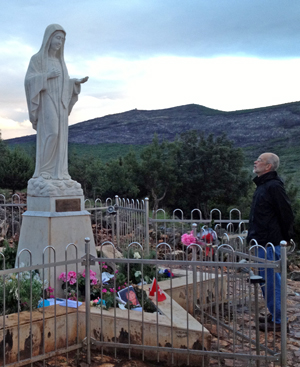By Dan Ebener

We made the walk alone. A steep, slippery walk from the village to the statue. It was a cold and rainy evening.
We had figured to follow the crowds to the famous statue of Mary, but very few people were on the hillside when my friend Rino Medic and I arrived in Medjugorie on May 26 for our pilgrimage. The sharp, red stones that make the path had become very slippery when wet. We cringed with each step as we treaded uphill. Careful to keep our heads down, we missed an obvious turn when the statue was clearly in sight.
After a treacherous 30 minutes of climbing (on what should have been a 15-minute walk), we suddenly came face-to-face with Mary (see photo). And just as suddenly, all was at peace. I could feel a warm embrace of what I attributed to Mary’s presence.
The point of this article is not to examine the controversial questions about whether Mary miraculously appeared to six children of Medjugorie in 1981. Nor do I intend to critique the Vatican investigation into Medjugorie, which is ongoing.
My pilgrimage was evidence enough for me to believe that God is moving in a powerful way in this tiny village that has become a destination point for an estimated one million pilgrims every year.
My objective here is to share three personal observations from my sociological perspective:
1. What is happening at Medjugorie is causing a revival of faith for a massive number of people, many of them youths and young adults, who are becoming more devout Catholics because of this experience. I could see it with my eyes and hear it in the voices of the pilgrims there.
It was a Sunday evening when we arrived and the church was overflowing. Outside the church, a large screen had been set up to televise Mass for the hundreds of people who were standing under makeshift shelters or under trees or exposed to the rain.
2. The message for peace that is associated with “Our Lady of Medjugorie” is coming at a critical time and place. “I am the Queen of Peace, 25 VI 1981” is the inscription on the famous statue of Mary on the hillside. (The numbers signify June 25, 1981, the date when the children first claimed to see the Marian apparitions.)
Medjugorie is in the heart of the Bosnia-Herzegovina region that has been at war for centuries. It is a place where four empires have collided: Austrians from the north, Turks from the south, Venetians from the west and Russians from the east. Each has brought its own heartbreak. Medjugorie has been a place of bigotry, war and ghastly massacres.
The various and complex conflicts in this region, now settled primarily by Catholics, are yet to be resolved. Tensions are still very high, particularly among the Croatian Catholics, the Serbian Orthodox and the Bosnian Muslims.
3. The happenings at Medjugorie have spawned economic development in an area hard pressed for jobs. Before the Bosnian War, this area had nearly 100 percent employment. But the war left the whole country poor, depressed and in desperate need for outside investment.
Driving from Zagreb to Sarajevo four years ago, I was shocked to see the number of bombed-out buildings dotting the countryside for hundreds of miles. Driving through Mostar on this visit, I was shocked again to see these shelled-out buildings in the middle of a city. (This is 20 years after the war.) But near Medjugorie, there is new construction for miles around.
This may seem insignificant to some readers. In fact, many of the shops that sell religious trinkets (from China) are distracting and troubling. Yet it is hard to build peace without economic justice. The investments into this part of Bosnia are very significant to the local people.
In conclusion, it seems that something special is happening in Medjugorie. People are becoming more devout. They are turning to Jesus. They are praying for peace. And they are giving credit to Mary.
(Dan Ebener is director of stewardship and parish planning for the Davenport Diocese.)







